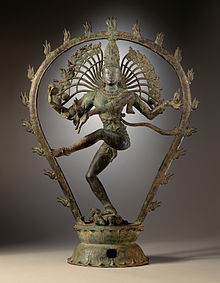Marga Natya
 |
Based on the study of Natya Shastra text, the common Indian grammar of performing arts and literature is referred to as Marga in the post-Natyashastra period. Deshis are regional forms of performing arts, many of which are developed based on regional taste.
Major Research[edit]
Marga Natya is the revival and reconstruction of Bharata (sage)’s tradition of dance, music and acting (natya, geeta and abhinaya) as mentioned in his Natya Shastra.[1]
Researcher Piyal Bhattacharya has been working at the Natyashastra with the support of the Sangeet Natak Akademi under their scheme of “Safeguarding Intangible Cultural heritage of India”.[2][3]
The Goal of Marga Tradition[edit]
The Natyashastra and other ancient Hindu texts such as the Yajnavalkya Smriti assert that arts and music are spiritual, with the power to guide one to moksha, through empowering the concentration of mind for the liberation of the Self (soul, Atman).[4], in strength similar to the knowledge of the Shrutis (Vedas and Upanishads).[4] Various medieval scholars, such as the 12th-century Mitaksara and Apararka, cite Natyashastra and Bharata in linking arts to spirituality, while the text itself asserts that beautiful songs are sacred and performance arts are holy.[4]
The goal of Marga Natya, states Natyashastra is ultimately to let the spectator experience his own consciousness, then evaluate and feel the spiritual values innate in him, and rise to a higher level of consciousness. The playwright, the actors and the director (conductor) all aim to transport the spectator to an aesthetic experience within him to eternal universals, to emancipate him from the mundane to creative freedom within.
The function of drama and the art of theatre, as envisioned in Natyashastra states Daniel Meyer-Dinkgräfe, is to restore the human potential, man's journey of "delight at a higher level of consciousness", and a life that is enlightened.[5]
References[edit]
- ^ "A symphony of dance, music and ancient cultural tradition". Times of India. Times of India. Retrieved 15 April 2024.
- ^ "Rising above the ordinary". The Statesman. Retrieved 15 April 2024.
- ^ "Regaling with traditional beauty". The Statesman. Retrieved 15 April 2024.
- ^ a b c Pandurang Vaman Kane 1971, pp. 45–46.
- ^ Daniel Meyer-Dinkgräfe (2005). Approaches to Acting: Past and Present. Bloomsbury Academic. p. 155. ISBN 978-1-4411-0381-9.
Quote: (…) "the function of the art of theatre, described in the Natyashastra is to restore full human potential, life in enlightenment. The concept of beauty in Indian tradition is, therefore, conceived and presented as the experience of delight at a higher level of consciousness."
Sources[edit]
- Pandurang Vaman Kane (1971). History of Sanskrit Poetics. Motilal Banarsidass. ISBN 978-81-208-0274-2.
